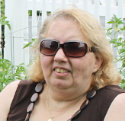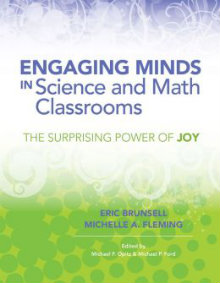Joyful Learning in Science, Math & STEM
Engaging Minds in Science and Math Classrooms: The Surprising Power of Joy
By Eric Brunsell and Michelle A. Fleming
Edited by Michael F. Opitz and Michael P. Ford
(ASCD, 2014 – Learn more)

Imagine always teaching with joy in mind ~~ what more could teachers and students want?
Teachers in every discipline want to engage the minds of their students. We not only want to impart knowledge but want to help build a love of learning as well. A follow-up to the book Engaging Minds in the Classroom: The Surprising Power of Joy (Opitz and Ford, 2014), this quick read provides examples of specific strategies math and science teachers can employ in classrooms to do just that.

The four basics of bringing joy to math and science
Creating joyful learning opportunities makes engagement likely. The authors of this book claim that there are four ways to promote this in math and science classrooms: build on student interest, focus on mastery goals, establish appropriate level of challenge, and incorporate feedback and self-reflection. The use of all four of these strategies enables the teacher to focus on the whole child.
Chapter Two addresses evaluating and assessing joyful learning. The main point is to ensure that students (and teachers) believe that they can succeed in learning math and science. Seeing connections to other areas through texts, materials and instruction is an important part of making this happen.
Using frequent formative assessment and providing relevant feedback to students also assist in building joy and feelings of self-efficacy. None of these ideas is new to experienced teachers but each serves as a positive reinforcement of good teaching practice.
Strategies for joyful learning throughout instruction
In the next chapter, “Implementing Joyful Learning in Science and Math,” the authors share specific strategies. For each of the five levels of learning environments (school community, classroom environment, whole-group instruction, small-group instruction, and individual instruction), activities designed to enhance learning experiences are described. My favorites were ‘Math Methods Madness Day’ for school-wide participation and ‘Show Me the Concept’ for small-group instruction. Both of these activities are designed to increase community and communication about math learning.
The last chapter describes how joyful, engaged learning supports today’s educational initiatives. Whether we are talking about Common Core Standards, RtI, addressing achievement gaps, or working to improve professional development, the principles behind joyful learning improve learning – just as these initiatives are designed to do. For instance, the Common Core Standards allow teachers to attack content in more meaningful, deeper levels. Using the Mathematical Practices as a guide, students can experience more authentic experiences and joyful learning.
For new STEM teachers and vets, too
The book explores all these ideas in 55 pages. It is a quick and easy read. After reading the introduction, I decided to read Engaging Minds in the Classroom: The Surprising Power of Joy (Opitz and Ford, 2014) first since this book is a companion to it. I found, however, that this book stands well alone. It is a great book for new STEM teachers as well as for experienced teachers who would like reinforcement of their positive practices.
Joyful teaching results in engaged, motivated students who love learning and retain more of what they learn. Can we ask for much more as teachers?
Lynne Menechella is currently an AIS math teacher in the Horseheads (NY) Central School District for Grades 5 – 8. She has a B.S. in Mathematics from William Smith College and a M.Ed. from Elmira College. With the district since 1984, she has also been a 7th grade math classroom teacher, an instructional support teacher, a team leader and a department chair. In addition, she was a NYS Math Mentor for several years. Lynne is married and has two adult children.
































